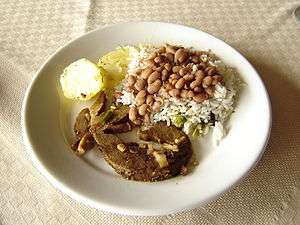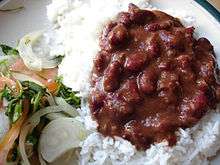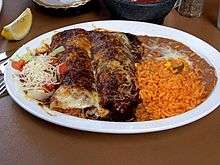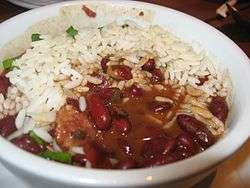Rice and beans

Rice and beans or beans and rice is type of dish made from a combination of staple foods in many cultures around the world. The grain and legume provide several important nutrients and many calories, and both foods are widely available. Rice and beans are vegetarian and make up a complete protein. The beans are usually seasoned, while the rice may be plain or seasoned. The two components may be combined or served separately.
Description

The dish usually consists of white or brown rice accompanied by cooked brown, red or black, dry beans (typically Phaseolus vulgaris or Vigna unguiculata) and seasoned in various ways. This dish is also commonly served with sides of stewed chicken, pork, beef, potato salad, boiled potatoes, and many other sides from many different cultures. In many areas, rice and beans are often served side by side rather than combined together. Either way, they may be considered a meal, frequently with a topping of meat or chicken. Meat or other ingredients are sometimes placed atop rice and beans or, less frequently, mixed into it.
Different regions have different preferences. In Brazil, for example, black beans are more popular in Paraná, Rio de Janeiro, Rio Grande do Sul and Santa Catarina, while in most other parts of the country these are mostly only used in feijoadas. The New Orleans specialty known as "red beans and rice" is often accompanied by a side of smoked sausage or a fried pork chop.
History
The Americas
Genetic analyses of the common bean Phaseolus shows that it originated in Mesoamerica, and subsequently spread southward, along with maize and squash, traditional companion crops.[1] Asian rice was introduced to Mexico and Brazil during the colonial era by the Spanish and the Portuguese. However, it has recently been discovered that the indigenous peoples of the Amazon had already cultivated a distant relative of Asian rice of the same genus Oryza some 4,000 years ago[2], and were growing it alongside maize and squash, traditional companion crops of beans, which were also by that time present in South America. Some recent scholarship suggests that enslaved Africans may also have played an active role in the establishment of rice in the New World.[3][4] It is also one of the most common food now in almost all of Spanish speaking countries.
Nutritional significance
Rice and beans is very nutritious. Rice is rich in starch, an excellent source of energy. Rice also has iron and some protein. Beans also contain a good amount of iron and a greater amount of protein than rice.[5] Together they make up a complete protein,[6] which provides each of the amino acids the body cannot make for itself.
Culture
In Latin American states and countries, rice and beans are commonly eaten as everyday lunch, along with a different variety of meats and vegetables. It is also common to prepare dinner using the lunch leftovers. Rice and beans are especially popular in Brazil, which is the world's third largest producer of dry beans[7] and the largest consumer of rice in the Americas.[8]
Dishes
- Arroz con gandules, a part of Puerto Rico's national dish which is rice with pigeon peas.
- Arroz junto, a Puerto Rican version of rice, meat and beans cooked together
- Feijoada, Brazilian national dish
- Gallo pinto, a Nicaraguan/Costa Rican version of rice and beans
- Hoppin' John, a black-eyed peas dish from the southern United States
- Kongbap, a Korean rice and beans dish
- Moro de guandules, a Dominican version of rice and pigeon peas
- Pabellón criollo, a Venezuelan version of rice and black beans with pulled beef.
- Platillo Moros y Cristianos, a Cuban version of fully mixed rice and black beans
- Rajma, an Indian bean dish usually served with rice
- Red beans and rice, the most common rice and beans dish in Louisiana Creole cuisine
- Rice and peas, a Caribbean staple dish
- Waakye, a Ghanaian rice and beans dish
- Bruine Bonen met rijst, a traditional Surinamese one-pot dish of meat, beans and rice
Other languages

Rice and beans is referred to as arroz y habas, arroz con habichuelas, arroz con frijoles, gallo pinto, recalentao or similar in Spanish, arroz e feijão, arroz com feijão or feijão com arroz in Portuguese,risi e bisi in Venetian language, diri ak pwa in Haitian Creole, avas kon arroz or avikas kon arroz in Judaeo-Spanish.
See also
References
- ↑ Mesoamerican origin of the common bean (Phaseolus vulgaris L.) is revealed by sequence data, Elena Bitocchi et al, PNAS, April 3, 2012, vol. 109 no. 14 > Elena Bitocchi, E788–E796, doi: 10.1073/pnas.1108973109
- ↑ "Evidence for mid-Holocene rice domestication in the Americas", Hilbert et al, Nature Ecology & Evolution (2017), doi:10.1038/s41559-017-0322-4, Published online: 9 October 2017
- ↑ Black Rice: The African Origins of Rice Cultivation in the Americas by Judith A. Carney
- ↑ National Research Council (1996-02-14). "African Rice". Lost Crops of Africa: Volume I: Grains. Lost Crops of Africa. 1. National Academies Press. ISBN 978-0-309-04990-0. Retrieved 2008-07-18.
- ↑ https://www.npr.org
- ↑ "Protein". cdc.gov. Centers for Disease Control and Prevention. 2012-10-04. Retrieved 2014-04-07.
- ↑ "Countries by commodity -- Beans, Dry". FAOSTAT. FAO. 2016. Retrieved 24 May 2018.
- ↑ "Rice around the world -- Brazil". International Year of Rice. FAO. 2004. Retrieved 24 May 2018.
Bibliography
- Embrapa, Origem e História do Arroz and Origem e História do Feijão (in Portuguese)
- Arroz e Feijão: Uma dupla infalível, Camaquã Alimentos (in Portuguese)
External links
| Wikimedia Commons has media related to Rice and beans. |
| Wikibooks Cookbook has a recipe/module on |
